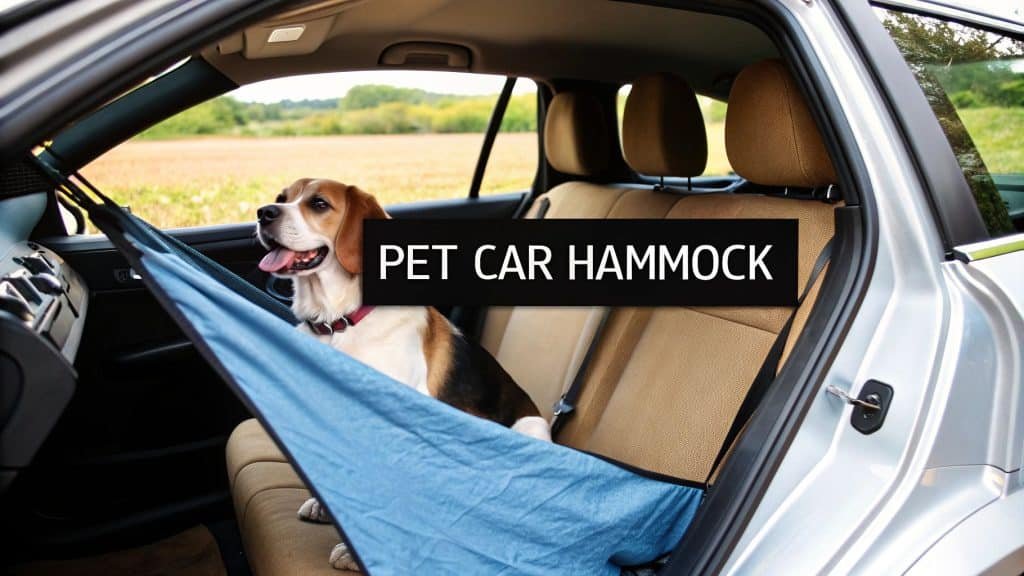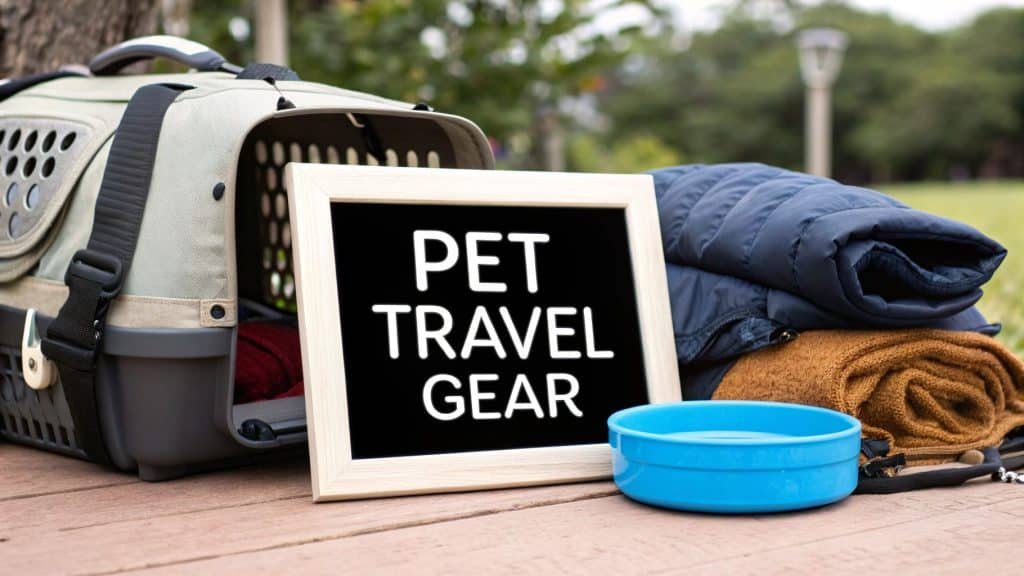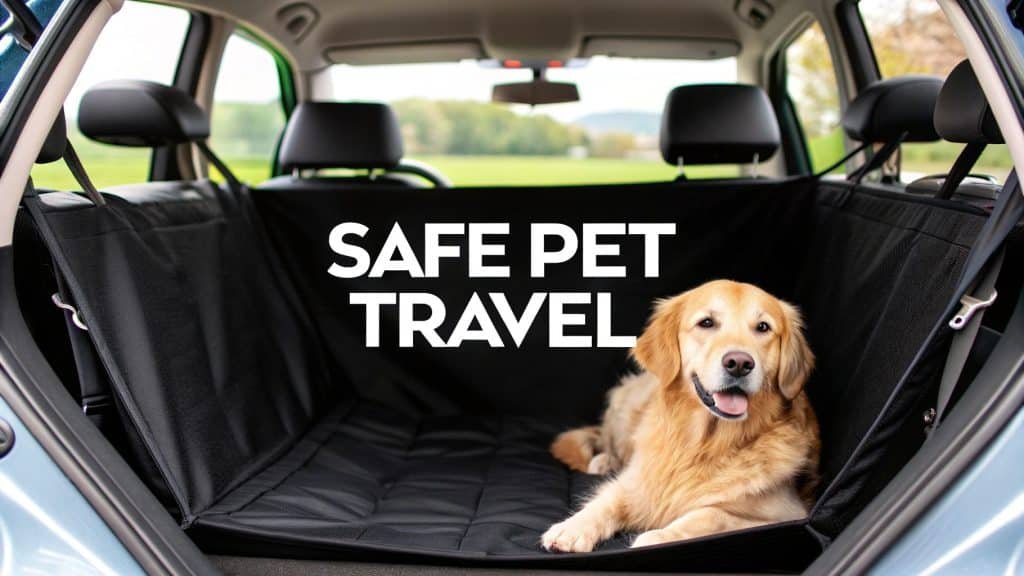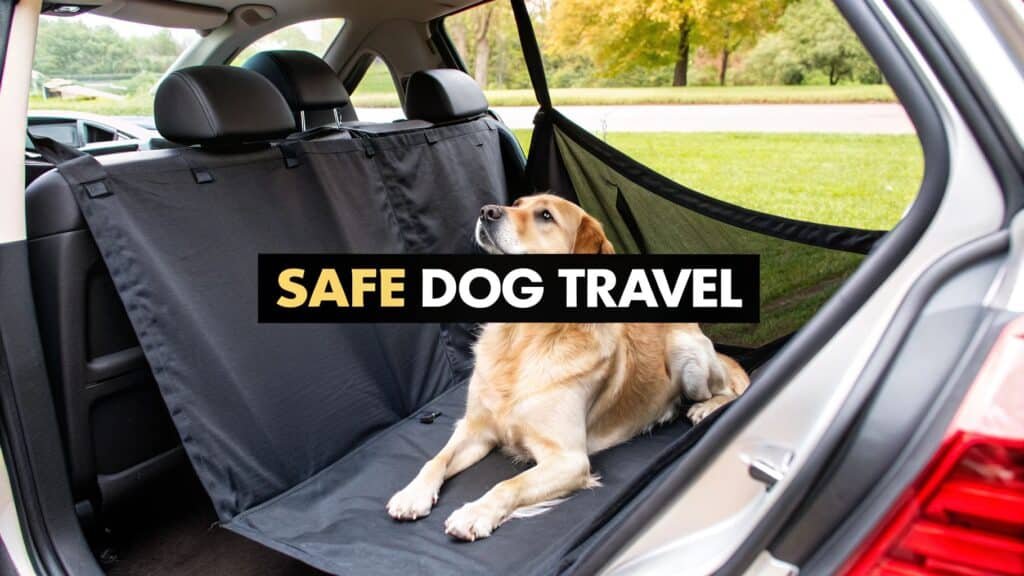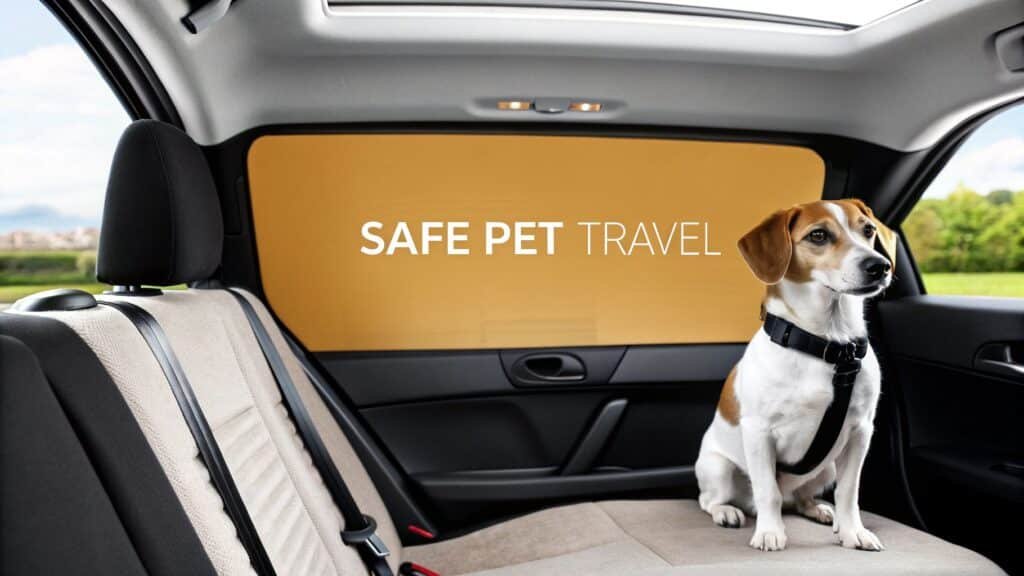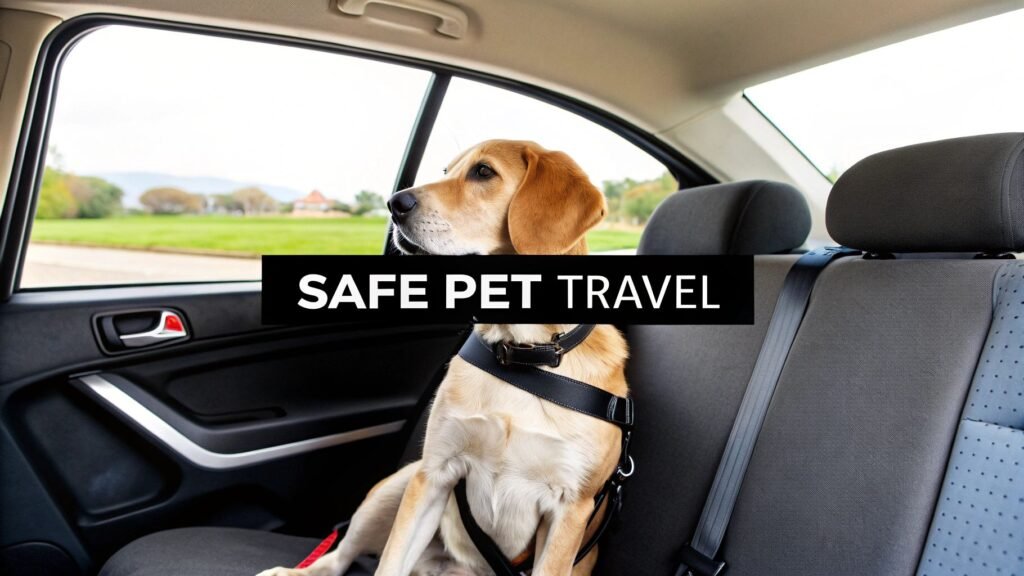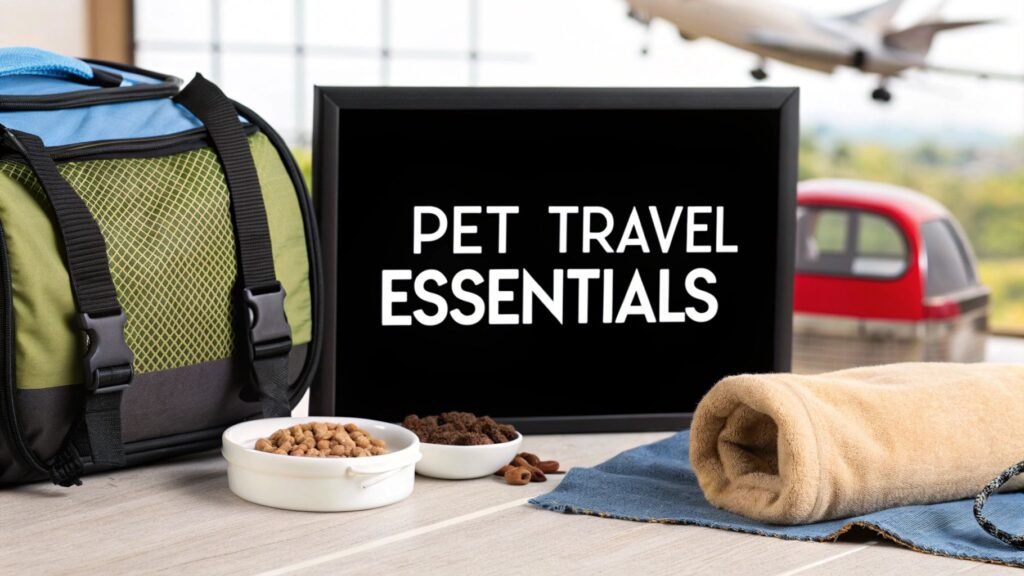The Essential Guide to a Seat Belt for Dogs
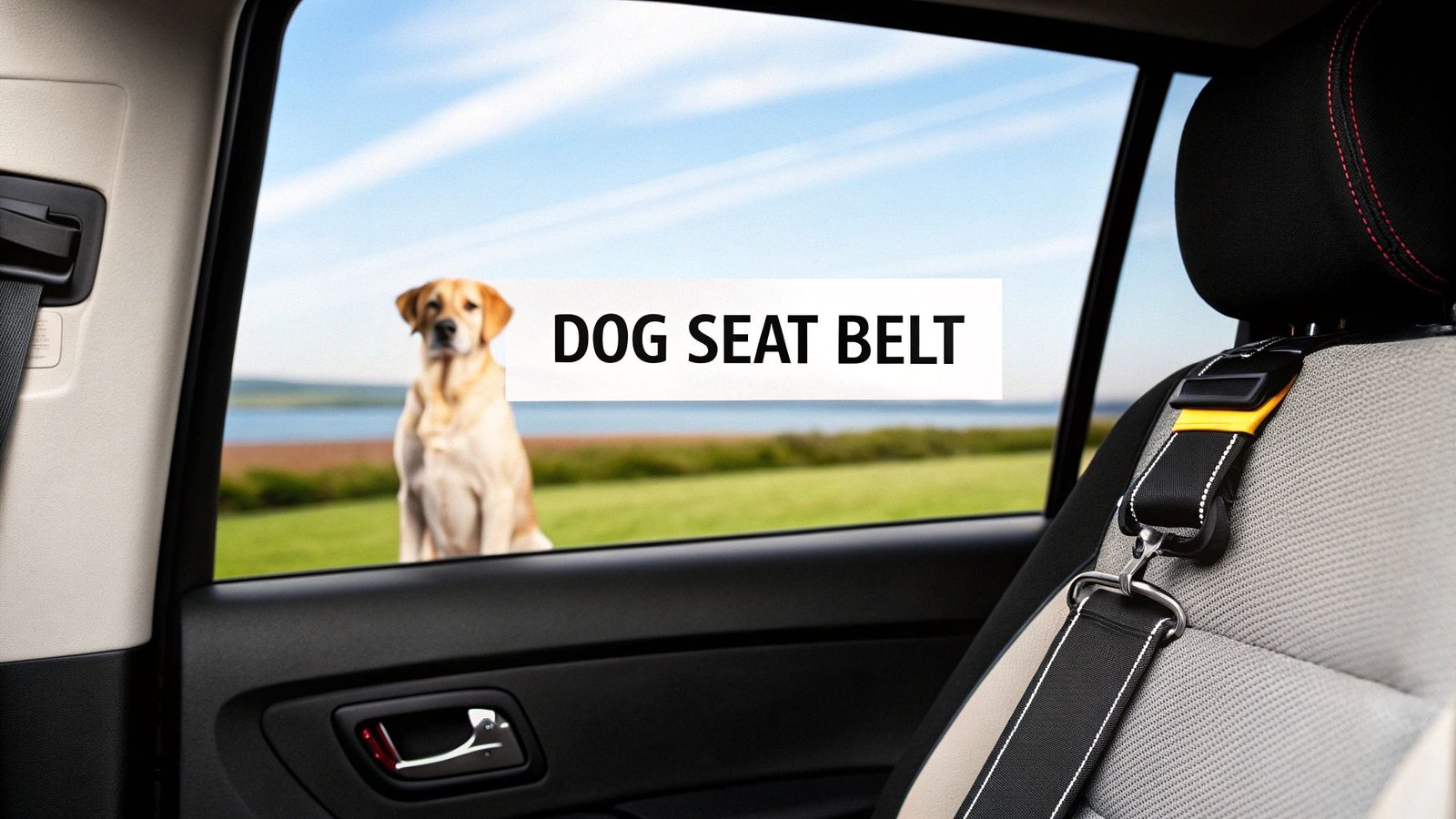
A seat belt for dogs is a purpose-built safety system that keeps your pet secure while you’re on the road. It works just like a human seat belt, connecting a specially designed, crash-tested harness to your car’s existing seat belt system. It’s not just a fancy accessory; it’s a fundamental piece of safety equipment for any responsible dog owner.
Why a Dog Seat Belt Is Non-Negotiable
We all love the classic image of a dog’s head out the car window, ears flapping in the wind. But the fun stops instantly in an accident. The hard truth is that an unrestrained dog becomes a dangerous projectile during a collision.
The physics are terrifying. In a crash at just 30 mph, a 60-pound dog can fly forward with a staggering 2,700 pounds of force. That’s enough to cause catastrophic injury to your pet and anyone else in the car. A proper dog seat belt is the only thing standing between your best friend and that awful possibility. It’s as essential as a car seat is for a child.
Understanding the True Risks
The danger isn’t just about the initial impact. A frightened, injured dog running loose after a crash can interfere with first responders trying to help you or your family. They can even bolt from the vehicle into traffic.
Even on a normal drive, a loose dog is a huge distraction. They might try to climb into your lap, block your mirrors, or just get underfoot.
Distracted driving is a major cause of accidents, and a dog roaming free in the car is a big contributor. Many states and local jurisdictions even have laws against it, meaning you could face fines for driving with an unrestrained pet.
This infographic really drives home the difference between a secured and unsecured pet in a vehicle.
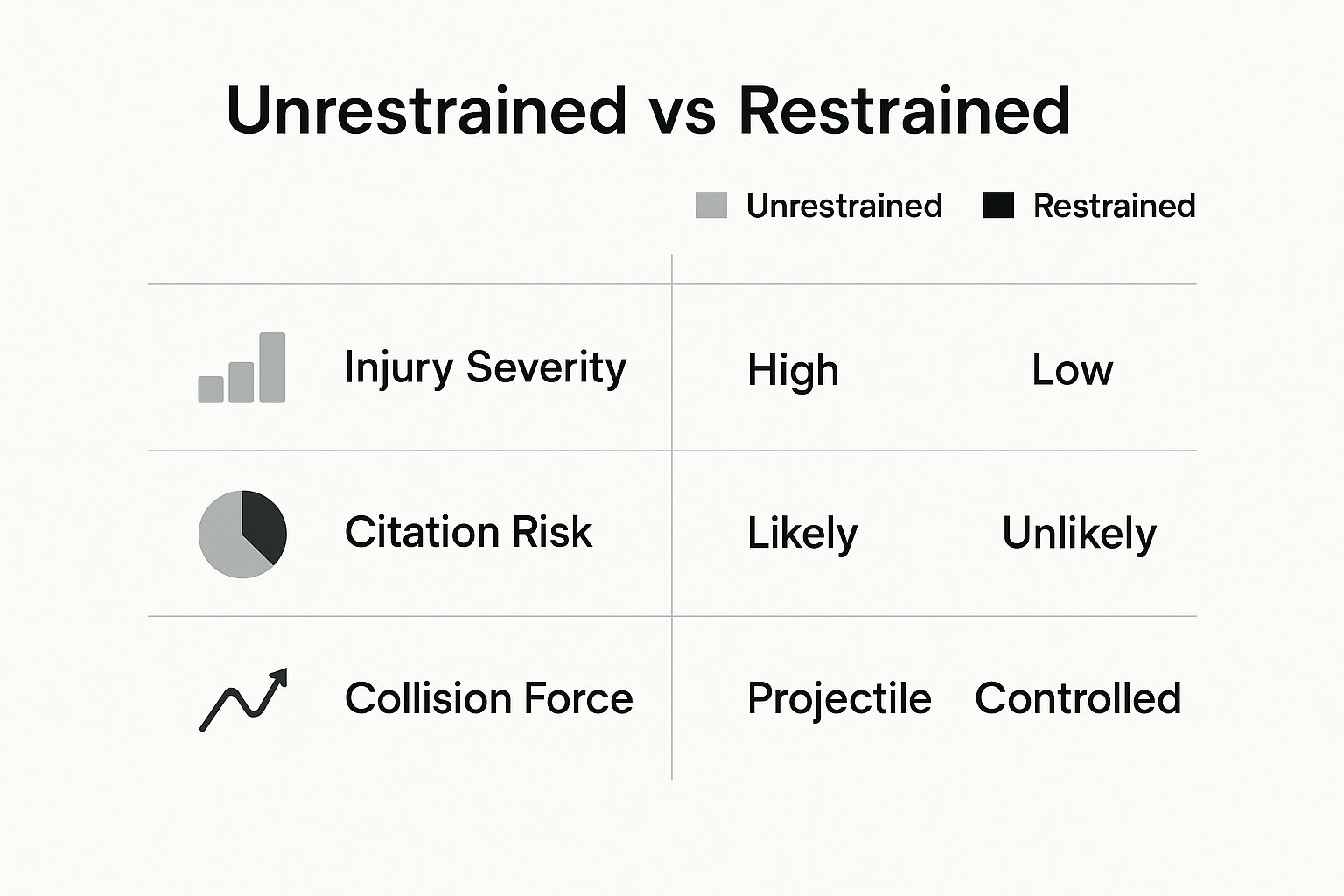
As you can see, a proper restraint system does more than just prevent fines—it dramatically reduces the chance of serious injury.
A Growing Trend in Pet Safety
More and more, we see our pets as true members of the family. This shift has led to a huge demand for better safety gear. Pet owners are no longer settling for flimsy accessories; they’re investing in products that genuinely protect their companions.
The market for dog car seats and restraints, including the seat belt for dogs, was valued at $600 million in 2023 and is only expected to climb. This isn’t just a fad; it shows a widespread understanding that our pets’ safety is a priority, not an afterthought. You can explore more on the growing pet accessories market to see how this trend is shaping the industry.
When you buckle up your dog, you’re making a deliberate choice to protect everyone in the car. It’s a simple action that makes every trip a safer, happier adventure for you and your four-legged co-pilot.
Decoding the Different Types of Dog Restraints
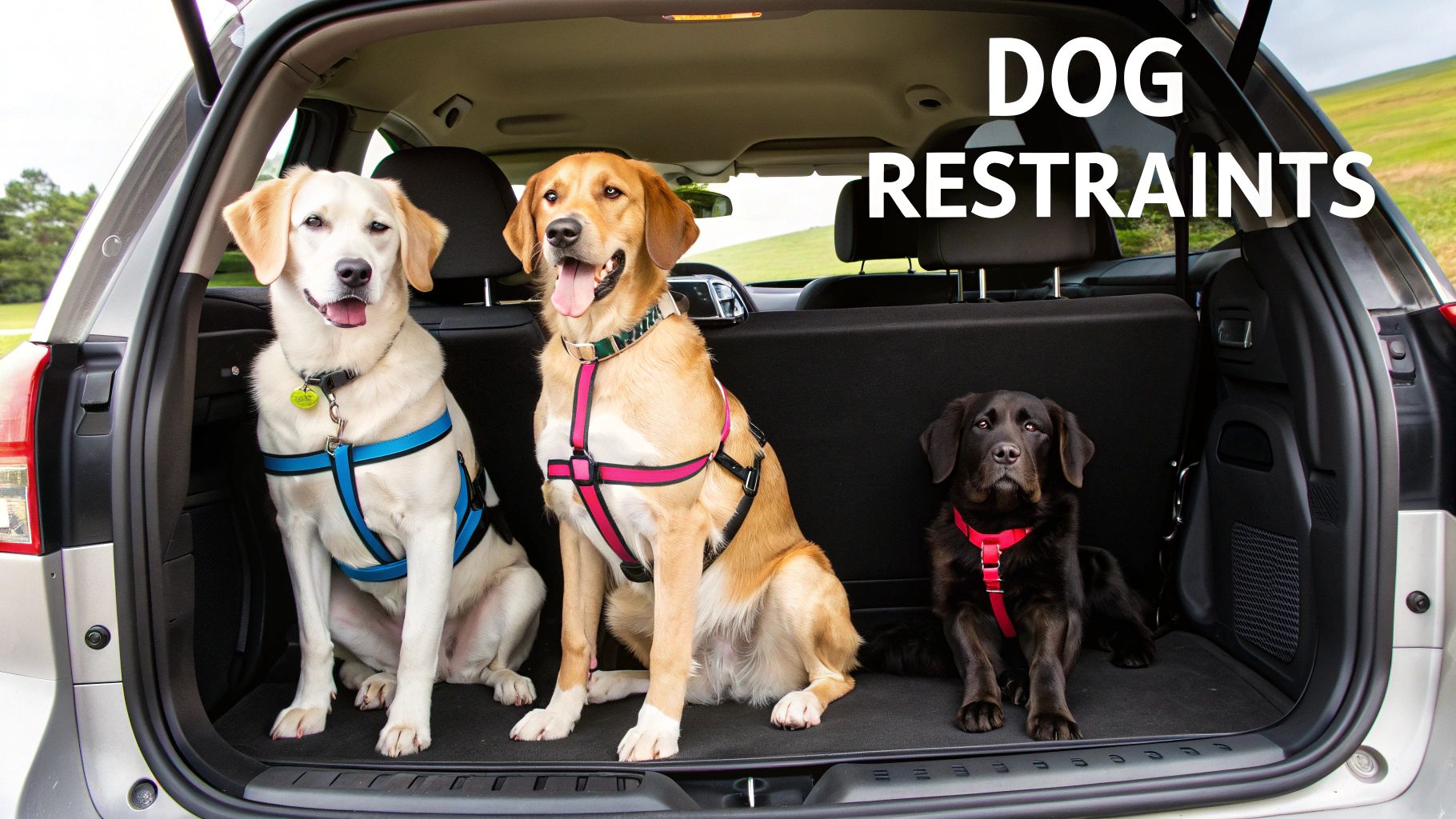
Choosing a seat belt for dogs isn’t a one-size-fits-all deal. There are a few different types of restraint systems out there, and the best one really depends on your dog’s size, personality, and even the car you drive. Figuring out these options is the first step to finding that sweet spot between safety and comfort for your furry co-pilot.
The most common setup you’ll see—and the one most experts recommend—is a harness-based tether. It’s pretty simple: a crash-tested harness on your dog connects to a short strap, which then hooks into your car’s seat belt buckle or LATCH system. Think of it as the dog version of our own seat belts, creating a secure link directly to the vehicle’s frame.
There’s a good reason this system is so popular. It offers serious protection by spreading the force of a sudden stop across the strongest parts of your dog’s body, like their chest and shoulders. It also keeps your pup in one spot, so they aren’t a distraction, while still giving them enough room to sit, stand, or curl up for a nap.
Harness and Tether Systems
For most dog owners, the harness and tether combo is the gold standard. It’s a straightforward and incredibly effective way to keep your dog secure in the backseat, dramatically reducing their risk of injury in an accident.
Here’s a quick look at how it all comes together:
- The Harness: This isn’t your average walking harness. A proper car harness is specifically built for safety, with reinforced webbing and heavy-duty steel hardware designed to handle extreme force.
- The Tether: This is the short, adjustable strap that connects the harness to the car. It’s the critical link that absorbs shock and prevents your dog from lurching forward.
- The Connection Point: The tether fastens to your car in one of two ways. It can either click directly into the seat belt buckle or clip onto the LATCH anchors you’d use for a child’s car seat.
That direct connection is what makes the system so dependable. It basically makes your dog part of the car’s safety structure, not just a passenger along for the ride.
Key Takeaway: The whole point of a harness and tether system is to create a safe zone for your dog. The tether should be just long enough for them to be comfortable but short enough to keep them from hitting the front seat or falling into the footwell in a crash.
Zipline Restraints
Got a dog that gets a little antsy being stuck in one spot? A zipline restraint might be the perfect solution. Picture a dog run, but inside your car. A sturdy strap runs across the backseat, usually hooked between the grab handles or coat hooks above the doors.
A separate tether attaches your dog’s harness to this zipline. This lets your dog move back and forth across the seat, giving them the freedom to look out both windows or find the perfect sunbeam. It offers more mobility than a standard tether but still keeps them from trying to become your co-pilot up front.
While this system gives them more room to roam, you have to make sure the zipline is pulled tight and the tether is kept short. Too much slack can make it less effective in a sudden stop. It’s a great option for calmer dogs who just appreciate a little more freedom.
Crate and Carrier Restraints
For smaller dogs or any dog who sees their crate as a safe space, securing a travel carrier in the car is a fantastic option. A tough, well-ventilated carrier acts like a protective shell. But just placing the crate on the seat won’t cut it—it has to be securely fastened.
You can do this by weaving the car’s seat belt through the crate’s handle or designated safety straps, then pulling it tight so the crate can’t slide or tip over. This ensures the carrier itself doesn’t become a projectile in an accident. Plus, it gives your dog a familiar, den-like space that can really help ease travel anxiety.
As more people bring dogs into their families, the demand for these crucial safety products is growing. The global pet seat belt market was valued at around $150 million in 2025 and is expected to keep climbing as more owners prioritize travel safety. This growth is largely thanks to the popularity of effective and comfortable solutions like harness-based systems. You can dive deeper into these market trends in pet safety to see how they’re shaping product innovation.
Comparing Dog Car Restraint Systems
With a few different options on the table, it can be helpful to see them side-by-side. Use this quick comparison to figure out which restraint system might be the best fit for your dog and your vehicle.
| Restraint Type | Best For | Pros | Cons |
|---|---|---|---|
| Harness & Tether | Most dogs of all sizes | Direct connection to car frame; Crash-tested for safety; Allows comfortable movement in one spot | May feel too restrictive for some anxious dogs |
| Zipline Restraint | Calm dogs who like more freedom | Allows lateral movement across the backseat; Prevents access to the front seat | Less restrictive, which can mean more movement during a crash; Requires careful installation |
| Crate/Carrier | Small dogs and anxious travelers | Provides a secure, den-like space; Contains messes; Can be crash-rated | Bulky and takes up significant seat space; The crate itself must be securely fastened |
Ultimately, the goal is to choose a system that you’ll use consistently and that keeps your best friend both safe and comfortable on every ride.
Choosing a Crash-Tested Dog Car Harness
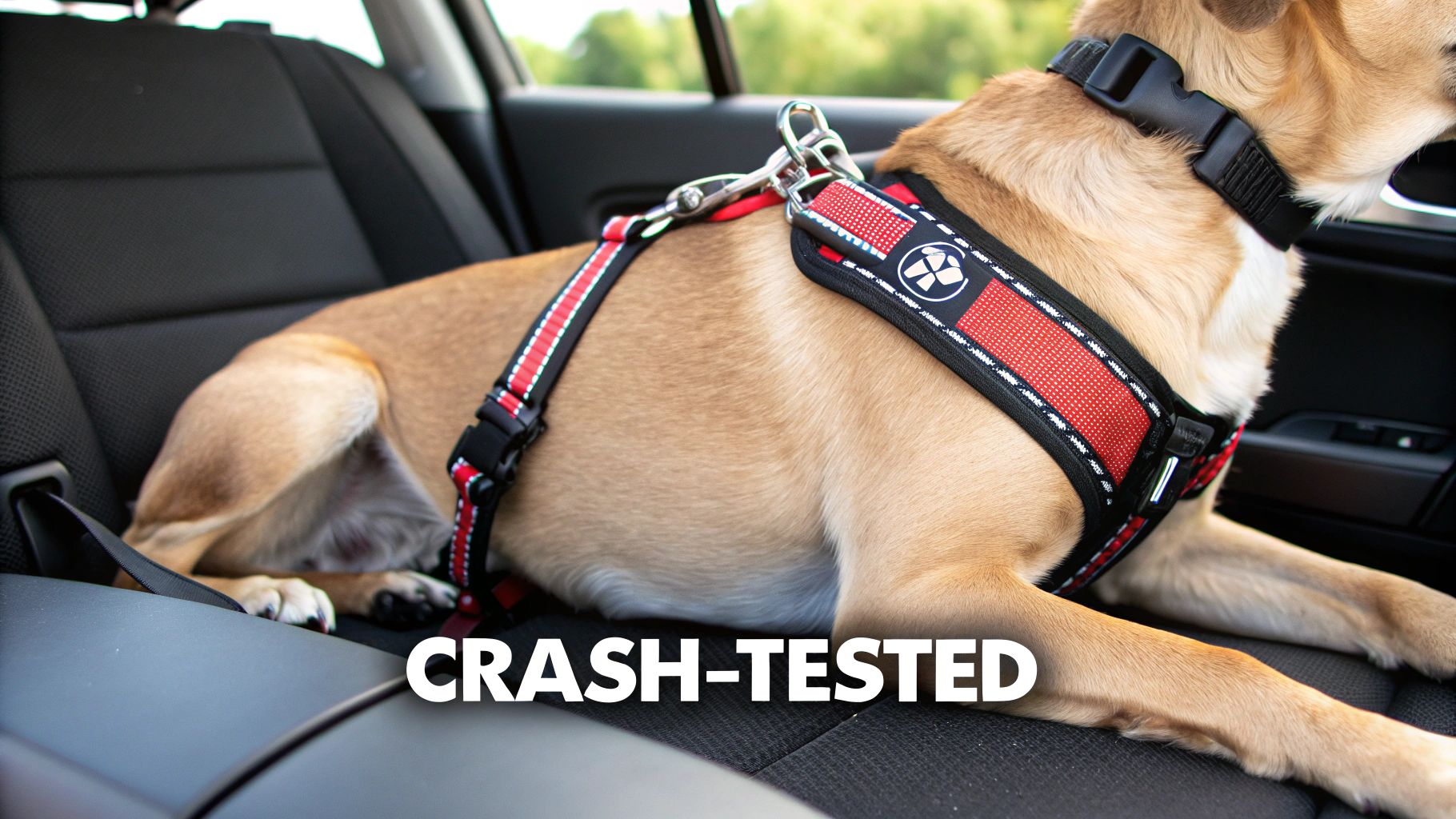
Let’s get one thing straight: not all harnesses are created equal. This is especially true when it comes to keeping your dog safe in the car. A standard walking harness is built to stop your dog from pulling on the leash, not to handle the incredible forces of a car crash. So, the single most important decision you can make is choosing a harness that’s been specifically crash-tested for car travel.
Think of it like this: a walking harness is like a comfy sweater, while a crash-tested car harness is like a professional stuntman’s safety gear. They might look similar, but they are engineered for wildly different jobs. The car harness is the absolute core of any good seat belt for dogs, working with a tether to keep your best friend secure.
This is specialized equipment, plain and simple. It’s an investment in smart engineering, tough materials, and your own peace of mind.
What Makes a Car Harness Different?
The real difference between a walking harness and a car harness comes down to how they’re built and what they’re built for. A car harness is designed from the ground up to absorb and redirect the kinetic energy of a sudden stop or impact, protecting your dog’s most vulnerable areas.
Here are the key features that really set them apart:
- Reinforced Materials: They’re made with automotive-grade webbing, just like human seat belts, which can handle thousands of pounds of force without failing.
- Steel Hardware: You’ll find heavy-duty steel buckles and connection points, not the plastic clips you see on most walking harnesses. Plastic can shatter on impact, making the harness useless when you need it most.
- Wide, Padded Chest Plate: This is a must-have. A broad, padded panel across the chest spreads out the force of an impact, shielding your dog’s fragile neck, trachea, and internal organs from injury.
These pieces all work together to create a safety system. The harness distributes the force, and the tether keeps your dog securely in their seat, stopping them from flying forward.
The Gold Standard of Safety Certification
So, how do you know if a harness is genuinely safe and not just cleverly marketed? The answer is independent testing. In the world of pet safety, the most trusted name is the Center for Pet Safety (CPS).
The CPS is a non-profit that puts pet safety products through intense, independent crash tests. They use specially designed crash-test dog dummies and follow strict protocols that are similar to the ones used for child safety seats. A harness that earns the CPS Certified seal has proven it can hold together and keep the dummy secure during a simulated 30 mph collision.
When you see the CPS Certified seal, it means the product has passed the toughest safety evaluation in the industry. It’s the closest thing we have to an official safety standard for a seat belt for dogs, and it’s a powerful sign that you can trust the product.
Without that certification, a “crash-tested” claim from a manufacturer is just words. The CPS seal is the objective proof you need to know your dog’s harness will actually work.
This growing demand for proven safety is clear in market trends. The global dog seat belt market is expected to hit an estimated $250 million by 2025 and is projected to grow at a rate of 8% through 2033 as more owners demand real safety solutions. You can dive deeper into these pet safety market projections if you’re curious.
Balancing Safety with Comfort
While safety is number one, a harness is only effective if your dog will actually wear it without a fuss. The best crash-tested harnesses are designed to be both protective and comfortable for the long haul.
Look for multiple adjustment points to get that perfect, snug fit that doesn’t rub or restrict movement. Your dog should still be able to sit, lie down, and shift around comfortably while staying securely tethered. Finding this balance is why exploring different collars, leashes, and harnesses is a great idea to find the system that offers both top-tier safety and everyday comfort for your dog.
Ultimately, choosing a crash-tested harness is about more than just a car accessory. It’s about turning your vehicle into a safe space for your companion and taking responsibility for their well-being on every single trip.
Getting the Perfect Fit and Installation
Even the best seat belt for dogs on the market is useless without the right fit. A harness that’s too loose is a major escape risk, and one that’s too tight can be uncomfortable or even dangerous. Nailing the fit and installation is the final, most important step to keeping your dog truly safe on the road.
Think of it this way: you wouldn’t drive a car without adjusting your seat and mirrors first. Those small tweaks are fundamental to your safety. The same logic applies here. A properly fitted harness turns a simple piece of gear into a life-saving system.
How to Measure for the Perfect Harness Fit
Before you can even think about installation, you need a harness that actually fits your dog’s body. Weight alone isn’t a reliable guide, since two dogs weighing 50 pounds can have wildly different builds. The only way to get it right is with accurate measurements.
Grab a soft, flexible measuring tape. The single most important measurement you need is the chest girth—that’s the circumference around the widest part of your dog’s ribcage, usually right behind their front legs.
With that number in hand, here’s what to do next:
- Measure the Neck: Gently wrap the tape around the base of your dog’s neck, right where their collar would normally sit.
- Check the Sizing Chart: Compare your chest and neck measurements to the manufacturer’s sizing guide. Every brand is different, so don’t assume your dog is a “medium” in everything.
- When in Doubt, Size Down: If your dog is between sizes, it’s almost always better to choose the smaller one. A slightly snug harness is far safer than a loose one.
Achieving a Secure and Comfortable Fit
Once you have the right size, it’s time to fine-tune the fit. This is where the tried-and-true “two-finger rule” is your best friend. You should be able to slide two fingers snugly between the harness and your dog’s body at any point—no more, no less.
This simple check ensures the harness is tight enough to prevent an escape but loose enough to avoid restricting their breathing or causing painful chafing. It’s the perfect balance of security and comfort.
Take your time during the first fitting. Loosen all the straps completely before putting the harness on. Then, methodically tighten each strap until you get that perfect two-finger fit all the way around. For a highly adjustable and rugged option, you might consider a tactical dog harness, which often has multiple adjustment points for a truly custom fit.
Installing the Tether in Your Vehicle
With the harness fitted perfectly, the last step is to connect the tether to your car. This is the piece that actually restrains your dog during a sudden stop or collision. There are two common ways to do this, depending on the type of seat belt for dogs you have.
1. Using the Seat Belt Buckle
This is the most common and straightforward method. The tether has a clip on one end that clicks right into your car’s seat belt buckle.
- Connect the tether’s other end (usually a carabiner) to the metal D-ring on the back of your dog’s harness.
- Click the tether’s buckle attachment into the car’s seat belt receiver, just like you would a normal seat belt.
- Adjust the tether’s length. Your dog should have enough room to sit or lie down comfortably, but not enough to roam the car or fall into the footwell.
2. Using the LATCH System
Most modern vehicles come with a LATCH (Lower Anchors and Tethers for Children) system built-in for child car seats. Some dog seat belt tethers are designed to connect to these incredibly strong anchor points.
- Find the LATCH anchors in your car. They are usually small metal bars tucked into the crease where the seat back and bottom cushions meet.
- Clip the tether’s carabiner directly onto one of these anchors.
- Attach the other end to your dog’s harness and adjust the length. This method creates a rock-solid connection directly to the frame of your vehicle.
Making Car Rides a Positive Experience
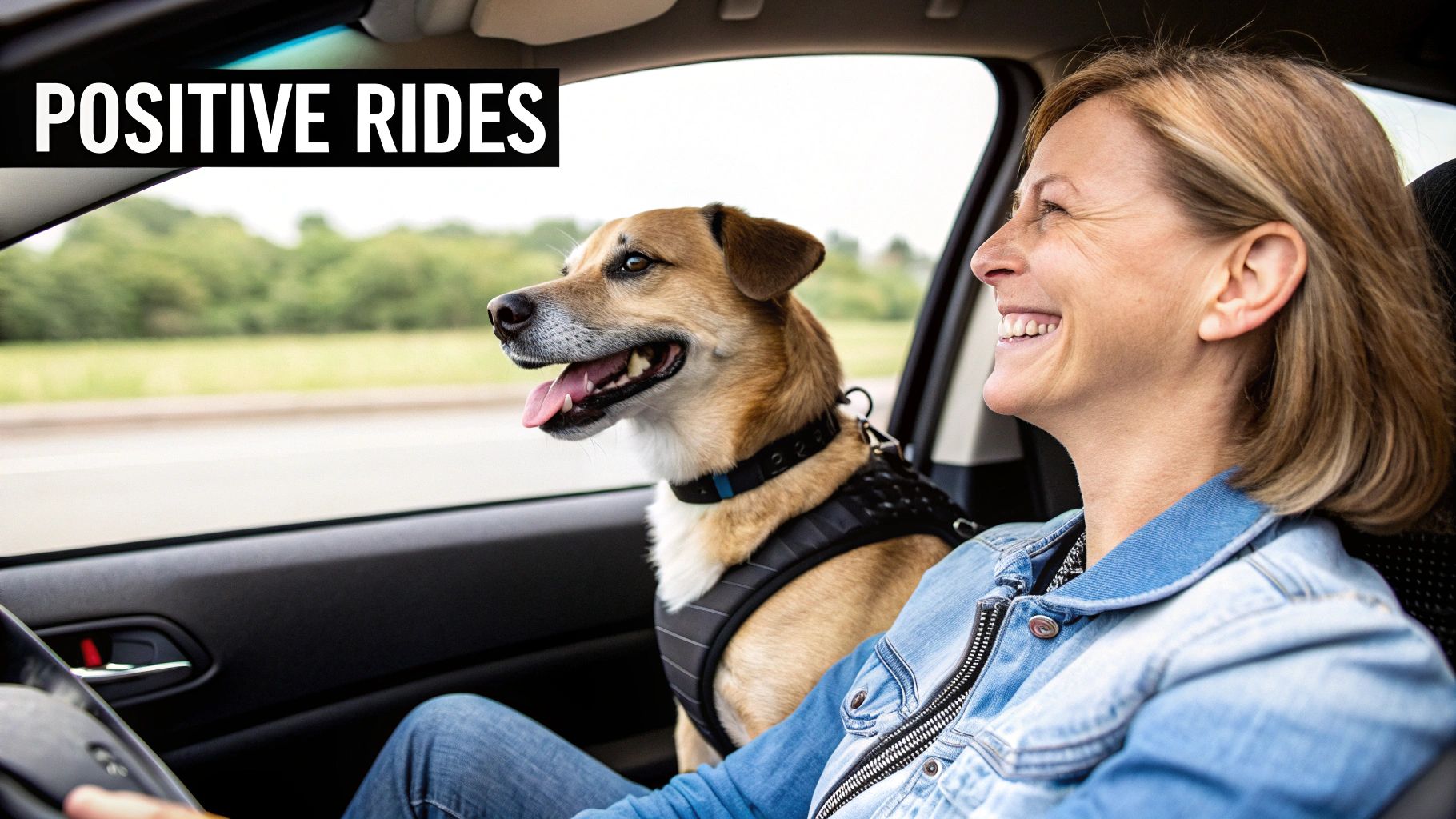
A crash-tested harness is an incredible safety tool, but it only works if your dog is willing to wear it. For a lot of pups, new gear feels weird, restrictive, or even a little scary. The secret isn’t forcing it on them; it’s about transforming their seat belt for dogs from a strange object into a sign that an adventure is about to begin.
Think of it like introducing your dog to a new, trusted friend. You wouldn’t force the interaction. You’d let them get to know each other slowly, building happy memories along the way. Your goal is to get your dog to want to put on their harness because they know it means something great is coming.
Start the Introduction at Home
The road to happy car rides starts long before you even jingle the car keys. The first and most important step is to build a positive connection with the harness in a calm, familiar place—your own home. This takes the stress of a moving car completely out of the equation.
Here’s a simple, step-by-step way to get started:
- Show and Treat: First, just let your dog sniff the new harness. As they check it out, give them a super tasty treat and lots of praise. Don’t even think about putting it on yet. You’re just teaching them that this new thing makes good stuff happen.
- Drape and Reward: Once they’re cool with the harness just being around, gently drape it over their back for a second. Then, take it right off and give them another treat. Keep these sessions short and repeat this a few times.
- Buckle and Celebrate: When your dog seems relaxed with the draping, buckle just one strap. Immediately unbuckle it and throw a mini party—a jackpot of treats and praise! Slowly work your way up to fastening all the straps, always keeping things quick and upbeat.
This gradual process ensures your dog never feels trapped or overwhelmed. Every tiny step forward is a win, building a foundation of trust that you’ll need for the next phase.
Move to the Parked Car
Once your dog is totally comfortable wearing their harness around the house, it’s time to bring the car into the picture—but keep it in park. The idea here is to get them used to being buckled in while the vehicle is completely still. A parked car in your driveway is the perfect, low-stress training zone.
Patience is your most important tool. Rushing this process can create anxiety that is difficult to undo. Every positive interaction, no matter how small, reinforces the idea that the car and the harness are safe and rewarding.
Have your dog hop into the backseat wearing their harness. Attach the seat belt tether and then give them a special chew toy or a puzzle feeder that they only get in the car. Sit with them for just a few minutes, talking in a calm, happy voice, and then get out. This teaches them that being buckled in the car is a normal, chill experience.
Take Short, Fun Trips
Okay, this is the final piece of the puzzle: connecting the entire experience to an amazing payoff. Start with super short trips—and I mean short—to places your dog absolutely adores. A quick drive around the block that ends at their favorite park is a perfect first outing.
Make the destination the real prize. The car ride is just the quick and safe way to get to the fun part. By consistently ending your practice drives with something wonderful, you’ll soon see your dog getting excited the moment you pick up their seat belt for dogs. They’ll have learned that buckling up is the official start of a brand-new adventure.
Keeping Your Dog’s Safety Gear in Top Shape
Your dog’s safety harness isn’t just an accessory; it’s a critical piece of equipment that works hard every time you hit the road. Think of it like the tires on your car—its reliability is everything. That’s why it needs regular checks to make sure it’s always ready to do its job.
A quick once-over before each trip can make all the difference, helping you spot a small issue before it becomes a real problem. Making this a quick, consistent habit is the best way to ensure the gear you trust to protect your best friend is always up to the task.
Your 30-Second Pre-Trip Inspection
Even the toughest materials will show signs of wear and tear over time. A simple, consistent check is the easiest way to catch degradation early and keep your dog safe.
Before you head out, take just a moment to run through this simple checklist:
- Check the Webbing and Stitching: Run your fingers over the fabric straps. Are there any signs of fraying, thinning, or small tears? Give extra attention to the stitching, especially around the buckles and connection points where the most force is applied.
- Test the Hardware: Click every buckle to make sure it fastens securely and isn’t cracked or warped. Look over the metal D-rings and any carabiners for signs of bending, rust, or other damage.
- Look at Overall Cleanliness: A build-up of mud, dirt, and fur can grind away at the fabric and jam up the buckles. Keeping the harness clean isn’t just about looks—it’s a key part of making it last.
A clean harness is a safer harness. For detailed advice on keeping all your pet’s gear in excellent shape, check out our selection of effective and pet-safe grooming and cleaning products designed for durability and care.
The Golden Rule: Replace After a Crash
This is the most important rule, and it’s not up for debate: any harness or tether involved in a moderate to severe accident must be replaced immediately. It doesn’t matter if it looks perfectly fine.
The incredible forces in a collision can cause tiny, invisible micro-tears in the webbing and create stress fractures in the hardware. You simply can’t see this kind of damage, but it severely compromises the gear’s ability to protect your dog in a future incident.
It’s the same reason you replace a child’s car seat after an accident. The hidden damage is real, and your dog’s life is worth the investment in a new, uncompromised restraint.
Answering Your Questions About Dog Seat Belts
Even after you’ve picked out the right gear, it’s totally normal to have a few lingering questions. Making sure you’ve got everything right gives you confidence that every car ride is as safe as it is fun for your furry co-pilot.
Let’s clear up some of the most common things pet parents ask about dog car restraints.
Can I Just Clip the Tether to My Dog’s Collar?
This is a hard no. In fact, it’s one of the most dangerous things you can do. When you attach a seat belt tether to a collar, all the immense force from a sudden stop or an accident gets focused directly on your dog’s neck.
Think about it—that’s a recipe for disaster. It can lead to severe injuries like whiplash, a collapsed trachea, or even strangulation. A good, crash-tested harness is non-negotiable because it’s built to spread that impact safely across the strongest parts of your dog’s body: their chest and shoulders.
Where’s the Safest Place for My Dog in the Car?
The back seat. Always the back seat. This rule applies to every dog, no matter how big or small. The reason is the same as it is for young kids: front-seat airbags. They deploy with incredible force and can cause serious, even fatal, injuries to a pet.
For the absolute best protection, secure your dog in the middle of the back seat. This spot provides the most buffer room in a side-impact collision. You’ll also want to make sure the tether is just long enough for them to sit and lie down comfortably, but short enough that they can’t lunge into the front seat or fall into the footwell if you slam on the brakes.
The whole point is to create a safe little pocket for them. They should have enough room to get comfy, but not so much that they can roam around and get into trouble or become a distraction.
Are There Official Safety Standards for Dog Seat Belts?
This is where it gets a little tricky. Unlike the seat belts we use, there are no official government regulations for pet travel restraints. This lack of a federal standard makes independent, third-party testing absolutely critical.
The Center for Pet Safety (CPS) has really stepped up to fill this gap. As an independent non-profit, they’ve become the gold standard for testing pet safety gear. The CPS puts harnesses and crates through rigorous crash tests that simulate real-world conditions.
Seeing a “CPS Certified” seal on a product means it has actually passed these tough evaluations and is proven to offer real protection. When you’re shopping, that certification is the single best indicator that you’re buying a genuinely safe seat belt for dogs.
At Ur Pet Store, we’re passionate about making every journey with your pet a safe one. We’ve hand-picked a collection of high-quality, durable harnesses and restraints designed to give you total peace of mind on the road.
Explore our full range of travel safety gear today at urpetstore.com


